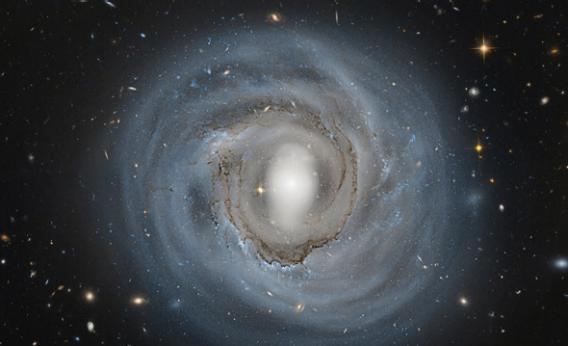Create a free profile to get unlimited access to exclusive videos, sweepstakes, and more!
Beauty Is Only Universe Deep

Galaxies come in many shapes and sizes. You can make broad categories for them â spiral, elliptical, irregular, peculiar â but even within those bins thereâs a lot of variation. Even more confusingly, they look very different depending on how you look at them: what telescope you use, what colors of light you use, and how you assemble the various observations into a single image.
NGC 4921 is a good, if spectacular, example of this. Itâs a face-on spiral located about 300 million light years away, deep in the huge Coma Cluster, a vast collection of galaxies with over a thousand citizens.
That Hubble image is breathtaking! It was put together by Roberto Colombari using observations from 2006 and 2007. Itâs not really true color; itâs a combination of observations using two filters; one that lets through light in the red to the near-infrared (shown as red in the image), and the other that lets through light from the blue-green to red (shown as blue in the image). He also created a âpseudo-greenâ color by combining the blue and red images. This doesnât add any real information, but helps produce a balanced three-color image thatâs prettier.
Still, thereâs a lot to see here. The most obvious feature is the spiral; the arms are clear though weaker than in most such galaxies. This is common with spiral galaxies in dense clusters; as they move through the cluster environment, gas between the galaxies can strip a galaxy of its own internal gas, much like you can roll down a car window to flush out the inside air as you drive down a highway. This ram stripping, as itâs called, can suppress the formation of stars, which in turn dampen the strength of the spiral arms themselves. Observations using different telescopes confirms that NGC 4921 is undergoing this sort of process. There is some ongoing star formation â you can see that as clumps of blue, where hot, massive stars are being born â but most spiral galaxies have a much stronger signal of this.
The next obvious bit is the complex structure of dust within the galaxy. This material blocks the light from stars behind it, so we see it as dark filaments twisted around the galaxy. I was surprised to see it popping out in this image, and all at roughly the same distance from the center. Rings of material like this sometimes happen after a galactic collision, or a near pass from another decent-sized galaxy. Again, thatâs common in clusters.
Also, you can see a lot of distance background galaxies as well. Most of these are much farther away, though some are also Coma Cluster members. NGC 4921 looks translucent in this image, actually, but again thatâs because itâs so low in dust and gas. You really can see right through it!
Hubble has observed this galaxy many times, because it has a special kind of star in it called a Cepheid variable. These stars pulse at a fairly predictable rate, and that rate is related to their actual, physical luminosity: how much energy they emit. That means that we can measure how bright they appear to be, and use that to determine their distance! This makes them benchmarks in space, allowing us to figure out how far away galaxies are.
Because of this, a different image of the galaxy was released back in 2009:
This image is a combination of red/infrared observations and some taken using a blue filter (and again, a pseudo-green channel made by combining the two). It looks very similar to the new image, but as you can see the colors are a bit more washed out. The dust isnât as obvious, nor are the star-formation regions. Thatâs all more an artifact of the filters used, but still, it shows that a galaxy can appear quite different just due to how you look at it.
These images of NGC 4921 are a good â and very beautiful â reminder that what you see is not what you get. There are many ways to see things, and they can all tell you something different and important. You have to be aware of that, and to know how to interpret it. Otherwise, how will you ever hope to understand the magnificent Universe around you?














